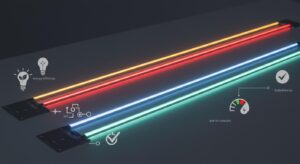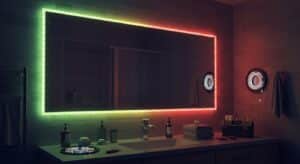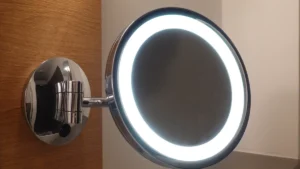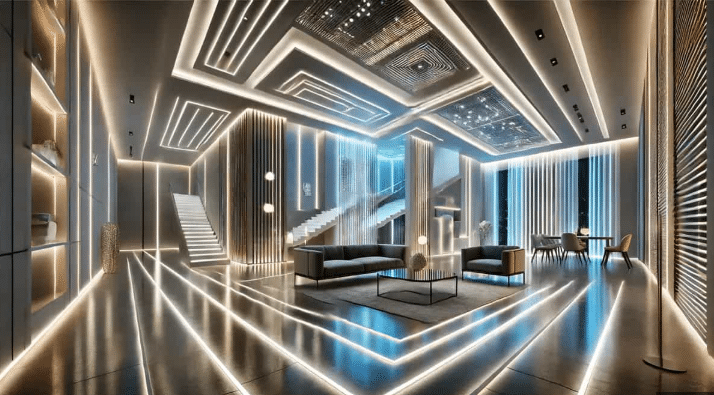
Architectural LED strip applications have transformed modern design in significant ways. They seamlessly blend style and functionality. These lights provide smooth illumination that is both aesthetically pleasing and highly effective. Their popularity is rapidly increasing. In 2023, the global market was valued at $4,417.64 million, and by 2031, it is projected to reach $12,046.15 million. You can utilize these lights to highlight designs, create ambiance, or assist with tasks. LED strips are energy-efficient and have a long lifespan, which also helps reduce energy bills. This makes them essential for architectural lighting projects.
Key Takeaways
Architectural LED strip lights save energy and reduce bills. They use up to 90% less power than old bulbs.
Choose the right type of LED strip for your project. Options include flexible, rigid, RGB, and waterproof strips.
Tunable white LED strips let you change light color. Use warm tones for relaxation and cool tones for focus.
Regular maintenance keeps LED strips bright and working well. Clean them often and check connections.
LED strips are eco-friendly. They last longer and reduce waste, making them a smart choice for homes and businesses.
Types of Architectural LED Strip Lighting

Architectural LED strip lighting comes in different types. Each type is made for specific uses. Knowing these types helps you pick the best one for your project.
Flexible LED Strip Lights
Flexible LED strip lights are very useful and adaptable. They can bend to fit almost any surface. This makes them great for creative designs or small spaces. These strips usually run on 12V or 24V DC. This saves energy and works with many power sources. A 5-meter strip can give up to 1200 lumens. It uses only about 24 watts, making it affordable for homes and businesses.
Main advantages include:
Energy efficiency: They use much less power than older lights.
Design flexibility: You can make cool lighting effects for accents or tasks.
These lights work well for under-cabinets, cove lighting, or outdoor areas if waterproofed.
Rigid LED Strip Lights
Rigid LED strip lights are stronger and more stable. Unlike flexible strips, they are fixed on hard boards. This gives better support and heat control. They are great for straight lines or fixed setups like display cases or building edges.
Rigid strips often have more LEDs, giving brighter and even light. They can run longer without losing power, especially with 24V DC. This makes them perfect for big projects like offices or factories.
RGB and RGBW LED Architectural Strip Lights
RGB and RGBW LED strip lights add bright colors to your designs. RGB strips mix red, green, and blue to make many colors. RGBW strips also include white light for more options. These are ideal for colorful effects in stores, hotels, or events.
Key details include:
Specification | Details |
|---|---|
LED Density | 60-120 LEDs per meter |
Color Range | RGB with adjustable white light (2700K-6500K) |
Control | Remote, app, or smart home control |
Input Voltage | 12V DC or 24V DC |
Wattage | 10W/m to 18W/m |
IP Rating | IP65 (dustproof and water-resistant) or IP67 (can go underwater) |
CRI | 90+ for bright and true colors |
These strips make amazing light effects with accurate colors. Whether for a club or fancy restaurant, RGB and RGBW strips improve the mood.
Tunable White LED Strip Lights
Tunable white LED strip lights let you change the light’s color. You can switch between warm white (2700K) and cool white (6500K). This makes them great for places needing different lighting during the day. For example, use warm tones for a cozy evening. Use cool tones for work or focus during the day.
These lights work well in homes and offices. At home, they brighten living rooms, kitchens, and bedrooms with flexible lighting. In offices, they boost focus by copying natural daylight. You can control them with dimmers, remotes, or smart systems for easy use.
Tunable white LED strips also save energy. They use less power than older lights, cutting energy costs. Their long life means fewer replacements, saving money over time.
High-CRI LED Strip Lights
High-CRI LED strip lights show colors very accurately. CRI, or Color Rendering Index, measures how true colors look under light. High-CRI lights, with a CRI of 90 or more, make colors bright and natural. They are perfect for art galleries, stores, and photo studios.
Here’s a simple look at their features:
Metric | What It Does |
|---|---|
TM-30-18 | Measures color accuracy and range using 99 samples. |
Color Quality Scale (CQS) | Rates color accuracy and viewer preferences using 15 samples. |
These lights make spaces look amazing. Use them to highlight products in stores or create a warm feel in restaurants. High-CRI lights ensure colors look real and vibrant.
Waterproof LED Strip Lights
Waterproof LED strip lights are made for tough conditions. They are great for outdoor areas like gardens, pools, and building walls. Indoors, they work well in wet places like bathrooms and kitchens.
These lights are tested to ensure durability:
IP Ratings: Numbers show how well they resist dust and water. Higher numbers mean better protection.
Waterproof Tests:
IPX 1: Tested with dripping water for 10 minutes.
IPX 5: Tested with sprayed water for specific times.
IPX 7: Tested underwater for 30 minutes.
Standards: International rules like ISO 20653 and IEC 60529 confirm their strength.
These waterproof strips last long and work in wet or dry places. Their strong build makes them a smart choice for many designs.
Benefits and Features of LED Architectural Lighting
Energy Efficiency and Cost Savings
LED strip lights save a lot of energy. They use much less power than old incandescent bulbs. For example, an incandescent bulb uses 60 watts. LED strip lights only need 8-12 watts. This saves up to 90% energy. Using less energy means lower electricity bills. This makes LED lights a smart choice for homes and businesses.
Energy Source | Energy Use (Watts) | Energy Saved (%) |
|---|---|---|
Incandescent Bulb | 60 | N/A |
LED Bulb | 8-12 | Up to 90% |
LED lights also save money over time. Many people recover their costs in two years. This is because of lower energy bills and fewer repairs. Businesses save even more with long-lasting LEDs that need fewer replacements.
Design Versatility and Flexibility
LED strip lights are very flexible. You can use them to create cool designs. They can be cut to fit different shapes, sizes, and colors. This makes them great for accent lighting, tasks, or decoration. Whether you want to highlight a feature or set a mood, LEDs work well.
Studies show how useful LEDs are in different places. For example, stores save 40% on energy and improve customer experience. Offices see better worker focus and comfort with improved lighting.
Case Study | Place Type | Main Benefits |
|---|---|---|
Retail | Stores | 40% energy savings, more customers, better shopping experience |
Corporate | Offices | 35% energy savings, better focus, improved daily rhythm |
Long Lifespan and Durability
LED strip lights last a long time. They can work for over 50,000 hours. This is much longer than regular bulbs. Even after 80,000 hours, most LEDs stay bright. This means you won’t need to replace them often, saving money and time.
LEDs last 25 times longer than old bulbs.
Good-quality LEDs stay bright even in tough conditions.
They are strong and work well in homes and factories.
Choosing LED lights means you get a lasting, energy-saving solution. They need little upkeep and give great lighting for years.
Customization Options for Unique Needs
LED strip lights are very flexible and easy to customize. They can be adjusted to fit different needs in homes, offices, or factories. Features like RGB capabilities and adjustable white light let you create cool effects for any mood.
Feature | Description |
|---|---|
RGB Capabilities | Lets you pick many colors, better than old lights. |
Adjustable White Temperatures | Changes from warm yellow (2700K) to cool blue (6500K) for the right mood. |
Modern LED strips work with smart home systems for easy control. You can change brightness, pick colors, or set schedules using your phone or voice. This makes them convenient and saves energy. DMX technology also gives precise control, perfect for events or creative designs.
Tip: Use dimming and color-changing features to save energy and set the mood.
These options make LED strip lights a great choice. They are both useful and stylish for any project.
Low Heat Emission and Safety
LED strip lights are safe and stay cool. Unlike older lights, they don’t get very hot, so there’s less risk of burns or fires. Special systems help manage heat and keep them safe.
Temperature Rise: Checks how hot parts get to keep them safe.
Heat Dissipation: Makes sure heat spreads out to avoid overheating.
These features make LEDs good for small spaces or places with heat-sensitive items. They are reliable and safe for homes, offices, or factories.
Eco-Friendly Lighting Solutions
LED strip lights are great for the environment. They use 75% less energy than old bulbs, cutting down on pollution. About 95% of their energy turns into light, making them very efficient.
LEDs last 25 times longer than regular bulbs, reducing waste.
Their energy-saving design lowers bills and helps the planet.
By choosing LED lights, you help the environment and save money. They are a smart, eco-friendly choice for homes and businesses.
Architectural LED Strip Applications
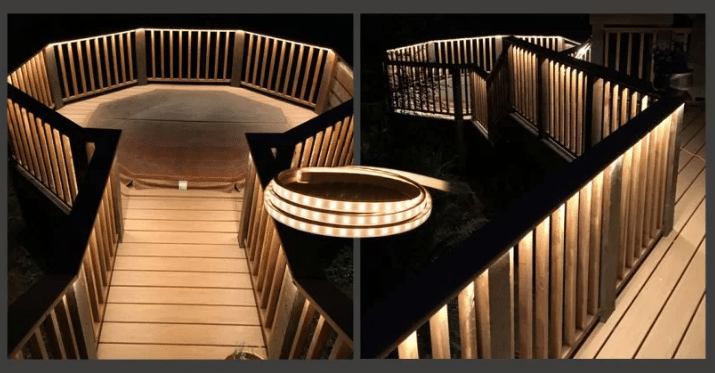
Architectural LED strip lights are useful for homes, businesses, and factories. They make spaces look better, work smarter, and save energy.
Residential Applications
Living Room Accent Lighting
LED strips can make your living room cozy and modern. Use them to brighten crown molding or add colorful lights behind your TV. These lights save energy and come in many designs, making them great for homes.
Kitchen Under-Cabinet Lighting
Under-cabinet lights help you see better while cooking. They also make your kitchen look stylish. LED strips give bright light and last a long time, so you won’t replace them often.
Bedroom Ambiance Lighting
Tunable LED strips can set the mood in your bedroom. Change the light color to relax at night or wake up with bright white light. These lights work with smart systems, making them easy to control.
Outdoor Patio and Garden Lighting
Waterproof LED strips are perfect for outdoor areas. Use them to light paths, show off garden features, or add soft light to patios. They are strong and stay cool, making them safe for outside use.
Commercial Applications
Retail Store Displays and Shelving
LED strips make products look great by giving bright, even light. High-CRI strips show colors clearly, making items more attractive. These lights also save energy, helping stores meet green goals.
Office Lighting for Productivity
LED lights help workers focus and get more done. They use 75% less energy than old bulbs, cutting costs. LEDs copy natural daylight, creating a comfy place to work.
Metric | Value |
|---|---|
Energy savings compared to incandescent lamps | 75% less energy consumption |
Energy efficiency of LEDs | 95% of energy converted to light |
Hospitality and Restaurant Ambiance
LED strips make restaurants and hotels feel welcoming. Use color-changing lights to match different events. These lights save energy while giving great lighting for guests.
Industrial Applications
Warehouse and Factory Illumination
LED strips give bright, even light for big spaces like factories. They use less energy but still light up well, saving money and lowering pollution.
Task Lighting for Workstations
Good lighting is important for detailed work in factories. LED strips give focused light, helping workers see clearly and avoid eye strain. They are tough and work well in busy places.
Tip: Pick strong LED lights for factories to save energy and last longer.
Decorative and Architectural Applications
Highlighting Building Facades
Architectural LED strip lights make building facades look amazing. They highlight features like windows, doors, or edges, making designs stand out. These lights show colors clearly, similar to natural daylight, so the building looks its best.
LED strips are very flexible. They come in many colors and brightness levels. You can pick warm tones for a cozy feel or cool tones for a modern look. Their small size lets you place them in tight spaces or unique patterns.
In businesses, these lights are both pretty and useful. They make buildings look great while improving safety and visibility. Energy-saving LED strips give stunning effects and lower energy use.
Tip: Pick high-CRI LED strips to keep facade colors bright and true, even at night.
Dynamic Lighting Effects for Events
Color-changing LED strip lights make events exciting and fun. They create colorful displays that match any theme or mood. Whether it’s a wedding, party, or concert, these lights add style and energy.
You can set the lights to change colors, brightness, or patterns. For example, slow color changes can feel calm, while fast ones bring excitement. You can control them easily with remotes or smart systems, making them perfect for event planners.
These lights make events unforgettable. They highlight stages or decorations beautifully. Plus, energy-efficient LEDs let you create amazing effects without wasting power.
Note: Use color-changing lights to match music or visuals. This makes events more exciting and memorable.
Installation and Maintenance of LED Architectural Strip Lights
Picking the Best LED Strip for Your Project
Choosing the right LED strip makes your project look great. First, think about what you need. Shorter runs work well with 12V DC strips. For longer runs, use 24V DC strips. Check the wattage to decide how bright the lights should be. High-wattage strips light up big spaces. Low-wattage strips are better for small accents.
The color temperature sets the mood. Warm white (2700K-3000K) feels cozy. Cool white (5000K-6500K) looks modern and fresh. For outdoor areas, pick strips with a high IP rating like IP65 or IP67. These resist dust and water. High-CRI strips (90+) show colors clearly, which is great for stores or offices.
Specification | Description |
|---|---|
Voltage | 12V DC for short runs; 24V DC for longer runs. |
Wattage | Higher wattage for big spaces; lower wattage for accents. |
Color Temperature | Warm white for cozy vibes; cool white for modern looks. |
IP Rating | IP65 or higher for outdoor use. |
CRI | 90+ for bright, true colors. |
Tip: Check if the strips can dim for flexible lighting.
Getting the Surface Ready for Installation
A clean surface helps your LED strip lights stick well. Find a flat area to install the lights. Clean it with a microfiber cloth and soapy water. Remove dust, grease, or moisture. Let the surface dry completely before starting.
For stronger installation, use aluminum channels. These make mounting easier and help manage heat. This keeps your lights working longer. Make sure the power supply and connectors match the LED strips to avoid problems.
Wipe the surface with a microfiber cloth and soapy water.
Dry the area completely to remove dust or grease.
Use aluminum channels for better heat control and neat looks.
Note: Good materials and prep work make your lights last longer.
Mounting LED Strips the Right Way
Mounting your LED strips properly keeps them secure and working well. For permanent setups, soldering connections is best. It gives a strong bond and steady power. Clip connectors are good for temporary setups. They let you adjust the lights easily.
Adhesive backing is simple to use but needs careful placement. For extra protection, mount the strips in aluminum channels with diffuser covers. These channels protect the strips from dust and spread heat evenly. They also make the lights look better.
Mounting Method | Description | Benefits |
|---|---|---|
Clean Surfaces | Make sure the surface is clean and dry. | Helps the strips stick securely. |
Peel and Stick | Use the adhesive backing to attach the strips. | Easy to use but needs careful placement. |
Aluminum Channels | Mount strips in channels with diffuser covers. | Protects strips, spreads heat, and looks neat. |
Tip: Test the lights by connecting the power before finishing the setup.
Wiring and Power Supply Basics
Good wiring and power supply are key for safe LED lights. Picking the right parts helps them last longer and work well. Choose a power supply that fits your LED strip’s voltage and wattage. For example, use 12V DC for short strips and 24V DC for long ones. Add 20% extra wattage to avoid overloading the power supply.
Follow safety rules to keep everything safe and legal. Important guidelines include:
ANSI and IEC rules for electrical safety.
UL 8750 for LED parts like drivers.
IEC 60598 for general light requirements.
47 CFR Part 15 for devices with radio signals.
Secure connections stop flickering or failures. Use soldering for permanent setups and clips for temporary ones. Cover all wires to avoid shocks. For outdoor use, pick waterproof connectors and power supplies with high IP ratings to handle weather.
Tip: Label wires during setup to make future fixes easier.
Maintenance Tips for Best Results
Regular care keeps LED strips working well. Check and clean them often. Dust can build up and dim the lights. Use a soft cloth or air spray to clean without harm.
Here’s a simple care schedule:
How Often | What to Do |
|---|---|
Weekly | Check lights and test if they work. |
Monthly | Clean dust, check wires and connections. |
Quarterly | Test controls, inspect drivers and ballasts. |
Annually | Replace old parts, review energy use, check emergency systems. |
Fixing small issues early stops big problems later. Test controls often to ensure smooth use. For outdoor lights, check for water leaks or sun damage.
Note: Keep a record of maintenance to track problems and fixes.
Fixing Common Problems
Sometimes problems happen even with careful setup. Fixing them fast keeps lights running. First, check the power supply. Make sure it matches your LED strip’s needs. Look for loose or broken wires that might stop power.
Steps to fix issues:
Look for damage like broken LEDs or cuts.
Check if wires are connected the right way.
Make sure wire size is correct to avoid flickering or heat.
Think about weather or heat that might affect the lights.
If flickering continues, use a multimeter to test the power supply. Replace broken strips or bad connectors if needed. Tighten all connections to keep lights safe and bright.
Tip: Use a surge protector to protect lights from power spikes.
Architectural LED strip lighting is very flexible and useful. It looks great and works well in many spaces. These lights save energy, last long, and can be customized. Installing them correctly and taking care of them keeps them working for years. Tests like LM-80 and TM-21 check how long LEDs stay bright. For example, LEDs with L90 B10 @ 80,000 hours keep 90% of their brightness after long use. Bright spaces also make places safer and leave good impressions, as shown in hotels and stores.
New ideas like smart lighting and better controls make these lights even more exciting. Using these features helps you create eco-friendly and amazing designs. Set them up properly and take care of them to make them last longer and work better.
Tip: Choose special LED options to fit your design and needs while keeping them working their best.
FAQ
What is the ideal voltage for LED strip lights?
The ideal voltage depends on your project. For shorter runs, 12V DC works well. For longer installations, 24V DC provides better performance and reduces voltage drop. Always match the voltage of your power supply to the LED strip for optimal results.
Can LED strip lights be cut to fit specific lengths?
Yes, most LED strips can be cut at marked intervals. These marks are usually spaced every 2-4 inches. Cutting at the wrong spot may damage the strip, so always follow the manufacturer’s guidelines.
How do you control the brightness of LED strip lights?
You can control brightness using dimmers or smart controllers. Many LED strips support remote or app-based dimming. Ensure your dimmer is compatible with the LED strip’s voltage and wattage for smooth operation.
Are LED strip lights safe for outdoor use?
Yes, but only waterproof LED strips with a high IP rating (IP65 or higher) are suitable for outdoor use. These strips resist water and dust, making them ideal for gardens, patios, and building exteriors.
How long do LED strip lights last?
High-quality LED strip lights last up to 50,000 hours or more. Their lifespan depends on factors like heat management, power supply quality, and usage conditions. Proper installation and maintenance can extend their longevity.
Tip: Regularly clean and inspect your LED strips to ensure they perform at their best.
